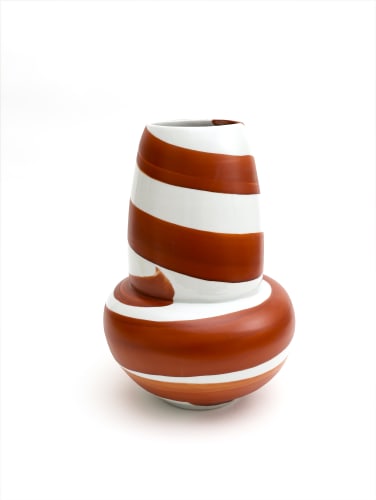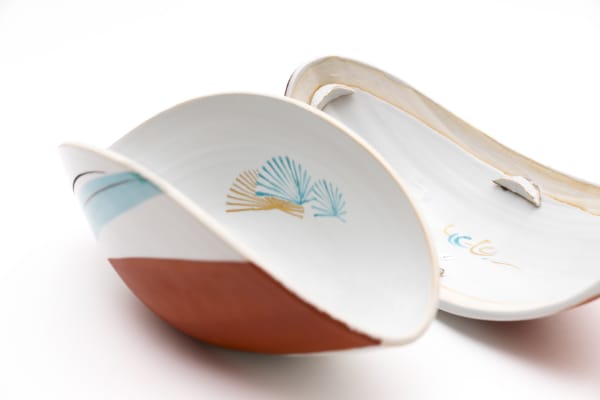Spiral: Ceramic works By Ken Akaji
Spiral
The shape of the Milky Way, of whirlwinds and whirlpools, snails and ivy tendrils—it is the form of the fundamental and mathematical energy of nature, and the pattern we, mankind, have used as a symbol of death and rebirth.
Ken Akaji was born in the city of Kanazawa in 1938. Kanazawa is a beautiful city, second only to Kyoto as a place where traditional culture not only survives, but flourishes. A castle town during the Edo period (1603-1868), it was home to the Shogun’s most trusted followers, the Maeda family. Kanazawa was a rich city with ample food, clothing and housing, and to this day, large numbers of its people are involved in traditional industries. This is the city where Ken Akaji was born and where, for sixty years, from the age of thirteen, he has continued to apply Aka-e designs to porcelain. However, his work differs slightly from the traditional Kutani-ware for which Kanazawa is famous. Among the old kilns of Japan, old Kutani stood out for its use of colorful glazes combined with gold coloring, producing flamboyant designs; many famous works remain and the area has produced large numbers of potters.
Akaji is a part of the Kutani ceramics world, but it would appear that his philosophical designs have always been driven by his rebellious spirit. He has struggled against taking the easy way presented by tradition, banal Kutani-ware, the arguably shallow aspects of contemporary art, and outdated ideas or concepts.
In his younger days, he was ‘convinced that [he] could express things through ‘shape’ and ‘red’ coloring alone.’ Despite his outstanding skill at the wheel, he often displays his creativity through works with distorted shapes. In addition, his choice of red coloring, symbolic of positive energy, dates back to memories of his youth. Until he was 15 years old, he lived in the district of Kanazawa that was famous for it’s geishas. He would observe the bengara (red iron oxide) that was used to paint the lattices on the front of the buildings in the area’s side streets – streets that were filled with the comings and goings of adult men and women. He reminisces that this is the origin of the red he uses in his work. Additionally, he comes from a family of lacquer workers. His grandfather was the ‘Living National Treasure’, Yusai Akaji, and his father produced the wooden bases for lacquer artists. So when Akaji left home to start work in the ceramics world, he chose red for his works, as it was the same red (vermilion) his family had used for generations in their own work.
The current ‘Spiral’ series of work appears to have stimulated his creative spirit. If you look closely at familiar vegetables, such as white radishes, carrots, onions, etc., you will notice that the leaves and roots create a junction where they meet, where the energies from both top and bottom conflict. It is the point at which the energy that flows from top to bottom and from bottom to top clash, that Akaji seeks to express through his porcelain. To these, he has added a red spiral drawn in a single stroke. There is another red spiral on the interior. This expresses the energy of Ken Akaji; it is the energy possessed by this quiet, mild-mannered, seventy-seven-year-old, that has exploded out from within, and has taken shape in the outside world.
Shoko Aono
Ippodo Gallery NY is delighted to announce that it will be holding the first solo exhibition outside Japan, of Japanese Aka-e porcelain by renowned master, Ken Akaji. The exhibition will be held from June 18 to July 3, 2015. Focusing on his latest ‘Spiral’ series, the exhibition will introduce forty works, including pots, bowls, plates and vases.
Ken Akaji was born in the city of Kanazawa in 1938. Kanazawa is a beautiful city, second only to Kyoto as a place where traditional culture not only survives, but flourishes. A castle town during the Edo period (1603-1868), it was home to the Shogun’s most trusted followers, the Maeda family. Kanazawa was a rich city with ample food, clothing and housing, and to this day, large numbers of its people are involved in traditional industries. This is the city where Ken Akaji was born and where, for sixty years, from the age of thirteen, he has continued to apply Aka-e designs to porcelain. However, his work differs slightly from the traditional Kutani-ware for which Kanazawa is famous. Among the old kilns of Japan, old Kutani stood out for its use of colorful glazes combined with gold coloring, producing flamboyant designs; many famous works remain and the area has produced large numbers of potters.
Akaji is a part of the Kutani ceramics world, but it would appear that his philosophical designs have always been driven by his rebellious spirit. He has struggled against taking the easy way presented by tradition, banal Kutani-ware, the arguably shallow aspects of contemporary art, and outdated ideas or concepts.
In his younger days, he was ‘convinced that [he] could express things through ‘shape’ and ‘red’ coloring alone.’ Despite his outstanding skill at the wheel, he often displays his creativity through works with distorted shapes. In addition, his choice of red coloring, symbolic of positive energy, dates back to memories of his youth. Until he was 15 years old, he lived in the district of Kanazawa that was famous for it’s geishas. He would observe the bengara (red iron oxide) that was used to paint the lattices on the front of the buildings in the area’s side streets – streets that were filled with the comings and goings of adult men and women. He reminisces that this is the origin of the red he uses in his work. Additionally, he comes from a family of lacquer workers. His uncle was the ‘Living National Treasure’, Yusai Akaji, and his father produced the wooden bases for lacquer artists. So when Akaji left home to start work in the ceramics world, he chose red for his works, as it was the same red (vermilion) his family had used for generations in their own work.
The current ‘Spiral’ series of work appears to have stimulated his creative spirit. If you look closely at familiar vegetables, such as white radishes, carrots, onions, etc., you will notice that the leaves and roots create a junction where they meet, where the energies from both top and bottom conflict. It is the point at which the energy that flows from top to bottom and from bottom to top clash, that Akaji seeks to express through his porcelain. To these, he has added a red spiral drawn in a single stroke. There is another red spiral on the interior. This expresses the energy of Ken Akaji; it is the energy possessed by this quiet, mild-mannered, seventy-seven-year-old, that has exploded out from within, and has taken shape in the outside world.
















